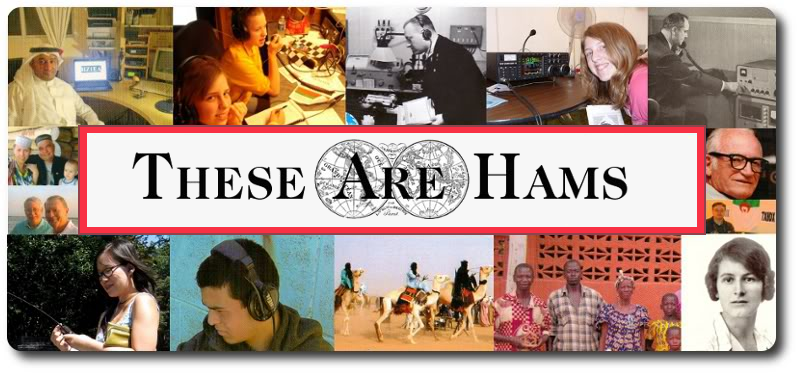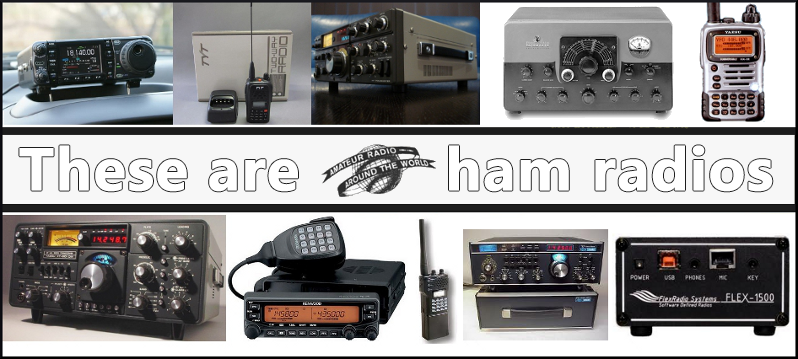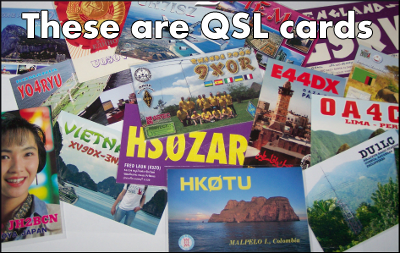What is Amateur Radio?
Amateur
radio
is a hobby in which people experiment with and communicate with radio.
The ability to experiment is an important distinction between amateur
radio and other services, such as Citizens’ Band, Family Radio, or
Business Radio. Because radio amateurs are allowed to experiment, they
are required to pass tests to prove a level of technical competence
before being granted a license.
There
are
three levels of amateur radio licenses currently offered in the U.S,
which vary in the degree of knowledge required and frequency privileges
granted. Each has a corresponding exam.
The
entry level, Technician Class exam, covers basic radio
fundamentals,
simple electroncs, and knowledge of basic rules and regulations. With
each step you gain more priveleges. The General Class, builds on what
you've already learned, and helps you to advance your technical and
operating skills. The final step in the amateur radio ladder is Extra
Class, which goes into more detail about the rules, specific operating
skills, and more advanced electronics theory. Once achieved, you will
be permitted to operate with all the privileges that the FCC grants to
amateur radio operators.
Hams
experiment with many different communications modes. Amateur radio is
not
just about talking to one another. Many hams like to use morse code,
while others connect a personal computer to a radio and use digital
modes, which
allow text-based chat and even the exchange of pictures over the air.
Part
of the fun is undoubtedly the challenge involved with understanding the
sometimes unpredictable nature of radio waves for communicating over
long distances. Some hams enjoy building their own radios and trying
them out on the air. Others may never build a piece of equipment, but
enjoy the challenge of making contacts with stations that are thousands
of miles away with very low power. Some hams enjoy experimenting with
ultra high frequency, operating from hilltops to get the best distances
using line-of-sight propagation. And others like to push the boundaries
of communication itself, by bouncing their radio signals off meteor
trails, or
even the moon. Hams can even make contacts using satellites that have
been built by radio amateurs and sent into orbit especially for ham
radio use.
Many
Profound discoveries have been made by ham radio operators...
A few
of them
are:
- John Logie
Baird, who‘s amateur experiments in the transmission of
pictures led to the development of television. On February 9, 1928, he
transmitted the world’s first inter-continental shortwave television
signal from a transmitter (call sign 2KZ), in Coulson, Surrey, England
to his colleague in the cellar of Robert M. Hart’s house, (call sign
2CVJ), in Hartsdale, New York.
- FM pioneer Frank
Gunther, (W2ALS), first established a two-way police
communications system in 1932.
- Hazard E Reeves,
(K2GL), invented the stereophonic sound system used
with Cinerama.
- Stan Danko,
(W2SGG), was the co-inventor of the printed circuit.
- Steve Wozniak,
(WA6BND), was the co-founder of Apple Computer.
- Jack St.
Clair Kilby, (W9GTY), was the winner of the Nobel Prize in
Physics in 2000, for his invention of the integrated circuit.
Experimentation,
however, is not the only justification for governments around the world
to preserve valuable frequency space for use by radio amateurs. In the
United States, ham radio operators are granted licenses for the purpose
of training themselves in wireless communication, while at the same
time they learn skills that are valuable for careers in engineering,
or communications technology. It also provides the country with a pool
of skilled radio operators for use in times of emergency. Ham radio
serves as a vital backup communication system when phone and power
lines are down. Radio amateurs relay information to emergency services,
each other, and government agencies when called upon. This
hobby is
not only fun. It can save lives.
 Ham radio operators are just
ordinary people with an interest in the magic of radio, and how a voice
can travel through space from the other side of the world and be
captured by a piece of wire, to be received loud and clear at their
station. Once licensed they wonder why they waited so long, as the
enjoyment of this hobby gets better and better as you explore it's many
possibilities. Ham radio operators are just
ordinary people with an interest in the magic of radio, and how a voice
can travel through space from the other side of the world and be
captured by a piece of wire, to be received loud and clear at their
station. Once licensed they wonder why they waited so long, as the
enjoyment of this hobby gets better and better as you explore it's many
possibilities.
Hams
are truly "citizens of the world." They
are men, women, and youngsters, the able and disabled from all walks of
life. National boudaries, politics, color, sex, or occupation, are no
barrier to amateur radio. Anyone can get
a license, no matter their age, or level of expertise. If you are
interested in getting your first license, we’re here to help. Contact
the Wireless Society of Southern Maine to learn more about licence
classes and test sessions in your area.
 
Amateur
Radios come in many varieties, depending on whether you want to set it
up as a base station, talk while you're on the road, or take it on the
go. Base station radios have all the bells and whistles, including
manual notch filters, built in digital signal
prosessing, antenna
tuners, electronic keyers, and offer multi band, multi-mode operation.
Many base station rigs features large digital readouts that display
everything from your transmit and receive frequencies, SWR graph, real
time spectrum scope, output and received signal meters, and more. They
generally offer 100W and 200W on HF, and around 50 on VHF and
70cm.
As
microprocessor technology has advanced, many of the features which were
only available on base station rigs a few years ago, are now being
offered on very small mobile transceivers as well. The Icom IC7000 is
the size of a VHF mobile radio, but offers "all band, all mode"
operation, as well as some advanced memory and digital signal
processing that can be found on larger, more expensive radios.
One
of the biggest advancements over the years has been in the performance
of handi-talkies, or HT's. Nowadays, they have excellent range, offer
dual band or even four band coverage, and can be operated on several
modes, including FM, AM, and digital. Some of these are no larger than
a cellular phone, and can easily fit in your pocket.
 |
To
a ham radio operator, a call sign is his or her identity. It serves as
a
passport into most countries via the airwaves, and identifies
the individual as well as their nationality to other hams around the
world. Each nation has
a unique prefix, which allows another station to immediately determine
where they are calling from. For example, all U.S.
hams have a prefix starting with either an A, K, N, or W.
Ham
radio is not anonymous. Once you copy a call sign, you can look it up
in one of the various call
|
books and
learn more about the other
station, including their address. This is important if you want to
exchange QSL cards...
Whenever
hams make a contact or “QSO” for the first time, they'll exchange
specially designed post cards through the mail. This serves as physical
proof
that the radio contact actually took place, and is a good way to keep
in touch.
QSL
cards often provide information
about the station, such as the operator's location, zone, grid square
and county as well as confirm and record details about the contact,
such as date, time, mode,
frequency, and a signal report. Many hams personalize their QSL cards
by including photos, artwork, other interests, and stories.
The
Technician license is the first license for newcomers to amateur radio,
and it is by far the most popular license held by U.S. hams. With this
license, you'll be able to communicate with thousands of other hams
using many of the modes available to amateurs. Once you gain
experience, you'll be ready to upgrade to Generall class, and
eventually to the top-of-the-line Amateur Extra class. These licenses
gain more privileges on the HF bands.
The first step is to
begin studying for your Technician class license. One way you can do
this is by taking one of our one-day courses, which will prepare you
for the exam, or study on your own. To get your license, you'll need to
pass a 35-question, multiple-choice exam on the rules of ham radio,
simple operating procedures and basic electronics. To gage your
progress, try taking a practice exam online. Once you start passing it
with some regularity, then its time to take your test.
Here
are some links to get you started:
|
|